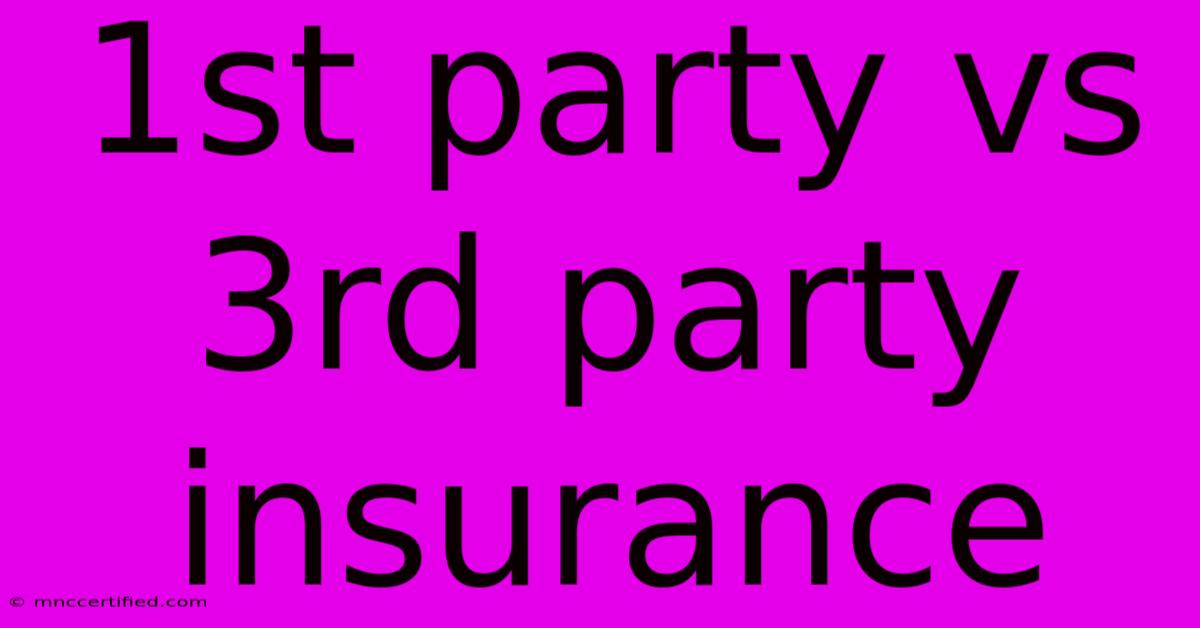1st Party Vs 3rd Party Insurance

Table of Contents
1st Party vs. 3rd Party Insurance: Understanding the Key Differences
Choosing the right insurance can feel overwhelming. One crucial aspect often misunderstood is the difference between first-party and third-party insurance. This comprehensive guide will break down the core distinctions, helping you make informed decisions about your coverage. We'll explore definitions, examples, and the implications of each type to ensure you're fully protected.
What is First-Party Insurance?
First-party insurance covers your own losses resulting from an insured event. This means you're making a claim against your own insurance policy. The insurer pays you directly for damages or losses you've suffered. Think of it as protection for your own assets and well-being.
Key Characteristics:
- Covers your losses: Damage to your property, medical expenses from an accident, or loss of income are examples of events covered.
- Claim against your own policy: You file a claim with your insurance company, not someone else's.
- Direct payment: The insurance company pays you directly for the covered losses.
Examples of First-Party Insurance Claims:
- Homeowners Insurance: Your house suffers damage from a fire. You file a claim with your homeowners insurer to cover repair or replacement costs.
- Auto Insurance (Collision & Comprehensive): Your car is damaged in an accident (even if it's your fault) or by something like hail. Your collision or comprehensive coverage pays for repairs.
- Health Insurance: You incur medical expenses due to an illness or injury. Your health insurer covers the costs based on your policy.
What is Third-Party Insurance?
Third-party insurance covers losses or damages you cause to someone else. In essence, it protects other people from your actions. You're making a claim against your insurance policy to compensate someone else for their losses.
Key Characteristics:
- Covers losses caused to others: This includes property damage, bodily injury, or other liabilities you're responsible for.
- Claim filed against your policy to compensate others: The injured party (or their insurer) claims against your policy.
- Payment to a third party: The insurance company pays the third party, not you directly.
Examples of Third-Party Insurance Claims:
- Auto Insurance (Liability): You cause an accident that damages another person's car or injures them. Your liability coverage pays for their repairs or medical bills.
- Professional Liability Insurance (Errors & Omissions): You make a mistake in your professional work that causes financial harm to a client. Your professional liability insurance covers the resulting damages.
- General Liability Insurance: Someone is injured on your property and you're found liable. Your general liability policy will cover the costs.
First-Party vs. Third-Party: A Clear Comparison Table
| Feature | First-Party Insurance | Third-Party Insurance |
|---|---|---|
| Coverage | Your own losses | Losses caused to others |
| Claimant | You | The third party (injured person, etc.) |
| Payment | To you | To the third party |
| Examples | Homeowners, Auto Collision, Health | Auto Liability, Professional Liability |
Understanding Your Policy: A Crucial Step
Carefully reviewing your insurance policy is paramount to understanding your coverage. Most policies contain a blend of first-party and third-party coverage, so it's essential to know what each part protects you from. Don't hesitate to contact your insurer or an independent insurance agent if you have questions about your specific policy and coverage limits. Understanding the nuances of first-party and third-party insurance is a critical step towards ensuring comprehensive protection for yourself and others.
Choosing the Right Coverage: Factors to Consider
The type and amount of insurance you need depend on several factors, including your assets, lifestyle, and risk tolerance. Consulting with an insurance professional can help determine the optimal balance of first-party and third-party coverage to meet your individual needs. Remember, proper insurance isn't just about cost; it's about peace of mind and financial security.
By understanding the differences between first-party and third-party insurance, you can effectively manage your risk and protect yourself from unforeseen circumstances. This knowledge is crucial for making informed decisions about your insurance coverage and ensuring you're adequately protected.

Thank you for visiting our website wich cover about 1st Party Vs 3rd Party Insurance. We hope the information provided has been useful to you. Feel free to contact us if you have any questions or need further assistance. See you next time and dont miss to bookmark.
Featured Posts
-
New Netflix Film Chad Michael Murray
Nov 21, 2024
-
Howard V Federal Crop Insurance
Nov 21, 2024
-
Burghart The Tories New Hope
Nov 21, 2024
-
Nba Rescinds Westbrooks Technical
Nov 21, 2024
-
Grateful Westbrook Hits 200 Trip Doub
Nov 21, 2024